Direct Simulation Monte Carlo Simulation of the Effect of Needle Valve Structures on the Rarefied Flow of Cold Gas Thrusters
Abstract
:1. Introduction
2. Numerical Simulation
2.1. Direct Simulation Monte Carlo Method
2.2. Simulation Models
2.3. Validations of the Numerical Results
3. Results and Discussion
3.1. Throttling Characteristic
3.2. Flow Regime Spatial Distributions and Local Kn Distribution
3.3. Multi-Scale Rarefied Flow Characteristics
3.4. Correlation of Flow Parameters with Curvature and Opening of Needle Valves
4. Conclusions
- The free molecular flow is concentrated near the wall of the expansion section of the nozzle and in proximity to the nozzle outlet. The extent of this region diminishes as the opening of the nozzle increases. Moreover, altering the curvature of the needle valve cone leads to a reduction in the Kn number distribution within the nozzle, consequently decreasing the size of the free molecular flow zone.
- In the throat and expansion section, increasing the curvature of the needle valve positively influences fluid velocity, with a higher absolute curvature value resulting in higher fluid velocities. Comparing different spool shapes, the conical spool shape reduces the velocity gradient in the spool area and the high-speed region near the outlet pipe when the opening is large. As the curvature of the spool increases, the velocity in the expansion section also increases. Consequently, an arc-shaped spool valve achieves the highest nitrogen flow rate at the nozzle during wide openings, thereby enhancing thrust.
- When the needle valve is at a small opening, the molecules tend to concentrate in the upper laryngeal cavity and microchannel due to the constriction effect of the throat. As the outlet of the nozzle is under vacuum conditions, the molecules disperse upon entering the expansion section of the nozzle from the microchannel. The macroscopic behavior observed is fluid expansion. This expansion becomes more pronounced as the absolute value of the curvature increases.
Author Contributions
Funding
Data Availability Statement
Conflicts of Interest
References
- Luo, J.; Chen, L.-S.; Duan, H.-Z.; Gong, Y.-G.; Hu, S.; Ji, J.; Liu, Q.; Mei, J.; Milyukov, V.; Sazhin, M.; et al. TianQin: A space-borne gravitational wave detector. Class. Quantum Gravity 2016, 33, 035010. [Google Scholar] [CrossRef] [Green Version]
- Hu, W.-R.; Wu, Y.-L. The Taiji Program in Space for gravitational wave physics and the nature of gravity. Natl. Sci. Rev. 2017, 4, 685–686. [Google Scholar] [CrossRef]
- Schleicher, A.; Ziegler, T.; Schubert, R.; Brandt, N.; Bergner, P.; Johann, U.; Fichter, W.; Grzymisch, J. In-orbit performance of the LISA Pathfinder drag-free and attitude control system. CEAS Space J. 2018, 10, 471–485. [Google Scholar] [CrossRef]
- Köhler, J.; Simu, U.; Bejhed, J.; Kratz, H.; Jonsson, K.; Nguyen, H.; Bruhn, F.; Hedlund, C.; Lindberg, U.; Hjort, K.; et al. A Hybrid Cold Gas Microthruster System for Spacecraft. Sens. Actuators A Phys. 2002, 97, 587–598. [Google Scholar] [CrossRef]
- Gamero-Castano, M.; Hruby, V.; Spence, D.; Demmons, N.; McCormick, R.; Gasdaska, C. Micro Newton Colloid Thruster System Development for ST7-DRS Mission. In Proceedings of the 39th AIAA/ASME/SAE/ASEE Joint Propulsion Conference and Exhibition, Huntsville, AL, USA, 20–23 July 2003; p. 4543. [Google Scholar]
- Keller, A.; Köhler, P.; Hey, F.G.; Berger, M.; Braxmaier, C.; Feili, D.; Weise, D.; Johann, U. Parametric Study of HEMP-Thruster Downscaling to μN Thrust Levels. IEEE Trans. Plasma Sci. 2014, 43, 45–53. [Google Scholar] [CrossRef]
- Ranjan, R.; Chou, S.K.; Riaz, F.; Karthikeyan, K. Cold gas micro propulsion development for satellite application. Energy Procedia 2017, 143, 754–761. [Google Scholar] [CrossRef]
- Ketsdever, A.; Mueller, J. Systems Considerations and Design Options for Micro Spacecraft Propulsion Systems. In Proceedings of the 35th Joint Propulsion Conference and Exhibition, Los Angeles, CA, USA, 20–24 June 1999; p. 2723. [Google Scholar]
- Chigier, N.; Gemci, T. A Review of Micro Propulsion Technology. In Proceedings of the 41st Aerospace Sciences Meeting and Exhibition, Reno, NV, USA, 6–9 January 2003; p. 670. [Google Scholar]
- Silva, E.; Deschamps, C.J.; Rojas-Cárdenas, M.; Barrot-Lattes, C.; Baldas, L.; Colin, S. A time-dependent method for the measurement of mass flow rate of gases in microchannels. Int. J. Heat Mass Transf. 2018, 120, 422–434. [Google Scholar] [CrossRef]
- Rothe, D.E. Electron-beam studies of viscous flow in supersonic nozzles. AIAA J. 1971, 9, 804–811. [Google Scholar] [CrossRef]
- Xie, C. Characteristics of micronozzle gas flows. Phys. Fluids 2007, 19, 037102. [Google Scholar] [CrossRef]
- Spazzini, P.G.; Fallerini, L. Performance analysis of a microthruster for satellite applications. Measurement 2019, 131, 782–786. [Google Scholar] [CrossRef]
- Darbandi, M.; Roohi, E. Applying a hybrid DSMC/Navier–Stokes frame to explore the effect of splitter catalyst plates in micro/nanopropulsion systems. Sens. Actuators A Phys. 2013, 189, 409–419. [Google Scholar] [CrossRef]
- Sabouri, M.; Darbandi, M. Numerical study of species separation in rarefied gas mixture flow through micronozzles using DSMC. Phys. Fluids 2019, 31, 042004. [Google Scholar] [CrossRef]
- Frieler, T.; Groll, R. Micro-nozzle flow and thrust prediction with high-density ratio using DSMC selection limiter. Front. Space Technol. 2023, 4, 1114188. [Google Scholar] [CrossRef]
- La Torre, F.; Kenjereš, S.; Moerel, J.L.; Kleijn, C.R. Hybrid simulations of rarefied supersonic gas flows in micro-nozzles. Comput. Fluids 2011, 49, 312–322. [Google Scholar] [CrossRef]
- Alexeenko, A.; Fedosov, D.; Gimelshein, S.; Levin, D.; Collins, R. Transient Heat Transfer and Gas Flow in a MEMS-Based Thruster. J. Microelectromech. Syst. 2006, 15, 181–194. [Google Scholar] [CrossRef]
- Sukesan, M.K.; Shine, S.R. Geometry effects on flow characteristics of micro-scale planar nozzles. J. Micromechanics Microengineering 2021, 31, 125001. [Google Scholar] [CrossRef]
- Bird, G.A. Approach to Translational Equilibrium in a Rigid Sphere Gas. Phys. Fluids 1963, 6, 1518–1519. [Google Scholar] [CrossRef]
- Darbandi, M.; Roohi, E. Study of subsonic–supersonic gas flow through micro/nanoscale nozzles using unstructured DSMC solver. Microfluid. Nanofluidics 2011, 10, 321–335. [Google Scholar] [CrossRef]
- Shang, Z.; Chen, S. 3D DSMC Simulation of Rarefied Gas Flows around a Space Crew Capsule Using OpenFOAM. Open J. Appl. Sci. 2013, 3, 35–38. [Google Scholar] [CrossRef] [Green Version]
- Sebastiao, I.B.; Santos, W.F. Impact of surface discontinuities on flowfield structure of a micro nozzle array. Nanoscale Microscale Thermophys. Eng. 2015, 18, 54–79. [Google Scholar] [CrossRef]
- Pulvirenti, M.; Wagner, W.; Rossi, Z. Convergence of particle schemes for the Boltzmann equation. Eur. J. Mechanics. B Fluids 1994, 13, 339–351. [Google Scholar]
- He, X.; He, B.; Cai, G. Simulation of rocket plume and lunar dust using DSMC method. Acta Astronaut. 2012, 70, 100–111. [Google Scholar] [CrossRef]
- Lee, K.H. Plume simulation of liquid apogee engine for GEO satellite using parallel DSMC method. Comput. Fluids 2020, 208, 104612. [Google Scholar] [CrossRef]
- Bird, G.A. Perception of numerical methods in rarefied gasdynamics. Prog. Astronaut. Aeronaut. 1989, 117, 211–226. [Google Scholar]
- Holman, T.; Osborn, M. Comparison of DSMC and experimental data for low Reynolds number micro-nozzle. In Proceedings of the 2018 Joint Propulsion Conference, Cincinnati, OH, USA, 9–11 July 2018; p. 4816. [Google Scholar]
- Holman, T.D.; Osborn, M.F. On the validation of direct simulation Monte Carlo method for low Reynolds number micro-nozzle resisto-jets. In Proceedings of the 35th International Electric Propulsion Conference, Atlanta, GA, USA, 8–12 October 2017. [Google Scholar]
- Shen, C. Rarefied Gas Dynamics: Fundamentals, Simulation and Micro Flows; Springer Science & Business Media: Cham, Switzerland, 2005. [Google Scholar]
- Bahukudumbi, P. A unified engineering model for steady and quasi-steady shear-driven gas microflows. Microscale Thermophys. Eng. 2003, 7, 291–315. [Google Scholar] [CrossRef]
- Bird, G.A. Molecular gas dynamics. NASA STI/Recon Tech. Rep. A 1976, 76, 40225. [Google Scholar]
- Bird, G.A. Monte-Carlo simulation in an engineering context. Prog. Astronaut. Aeronaut. 1981, 74, 239–255. [Google Scholar]
- Bird, G.A.; Gallis, M.A.; Torczynski, J.R.; Rader, D.J. Accuracy and efficiency of the sophisticated direct simulation Monte Carlo algorithm for simulating noncontinuum gas flows. Phys. Fluids 2009, 21, 017103. [Google Scholar] [CrossRef]
- Belotserkovskii, O.; Yanitskii, V. The statistical particles-in-cells method for solving rarefied gas dynamics problems. USSR Comput. Math. Math. Phys. 1975, 15, 101–114. [Google Scholar] [CrossRef]
- Stefanov, S.; Vargas, M. Particle collision algorithms based on Kac stochastic model. AIP Conf. Proc. 2011, 1389, 1134–1137. [Google Scholar]
- Roohi, E.; Stefanov, S.; Shoja-Sani, A.; Ejraei, H. A generalized form of the Bernoulli Trial collision scheme in DSMC: Derivation and evaluation. J. Comput. Phys. 2018, 354, 476–492. [Google Scholar] [CrossRef] [Green Version]
- Taheri, E.; Roohi, E.; Stefanov, S. A symmetrized and simplified Bernoulli trial collision scheme in direct simulation Monte Carlo. Phys. Fluids 2022, 34, 012010. [Google Scholar] [CrossRef]
- Stefanov, S.; Roohi, E.; Shoja-Sani, A. A novel transient-adaptive subcell algorithm with a hybrid application of different collision techniques in direct simulation Monte Carlo (DSMC). Phys. Fluids 2022, 34, 092003. [Google Scholar] [CrossRef]
- Scanlon, T.J.; White, C.; Borg, M.K.; Palharini, R.C.; Farbar, E.; Boyd, I.D.; Reese, J.M.; Brown, R.E. Open-Source Direct Simulation Monte Carlo Chemistry Modeling for Hypersonic Flows. AIAA J. 2015, 53, 1670–1680. [Google Scholar] [CrossRef] [Green Version]
- Wang, X.; Li, Y.; Gao, Y.; Gao, C.; Fu, W. DSMC Simulation of the Effect of Needle Valve Opening Ratio on the Rarefied Gas Flows inside a Micronozzle with a Large Length-to-Diameter Ratio. Aerospace 2023, 10, 126. [Google Scholar] [CrossRef]
- Liu, X.; Li, D.; Fu, X.; Gao, Y.; Wang, X. MODELING of Rarefied Gas Flows Inside a Micro-Nozzle Based on the DSMC Method Coupled with a Modified Gas–Surface Interaction Model. Energies 2023, 16, 505. [Google Scholar] [CrossRef]
- Maxa, J.; Bílek, M.; Hlavatá, P.; Vyroubal, P.; Lepltová, K. Comparisons Using Methods of Continuum Mechanics and Monte Carlo at Differentially Pumped Chamber. Adv. Mil. Technol. 2016, 11, 143–150. [Google Scholar] [CrossRef] [Green Version]
- Zakeri, M.; Roohi, E. Flow and thermal field investigation of rarefied gas in a trapezoidal micro/nano-cavity using DSMC. Int. J. Mod. Phys. C 2021, 32, 2150162. [Google Scholar] [CrossRef]
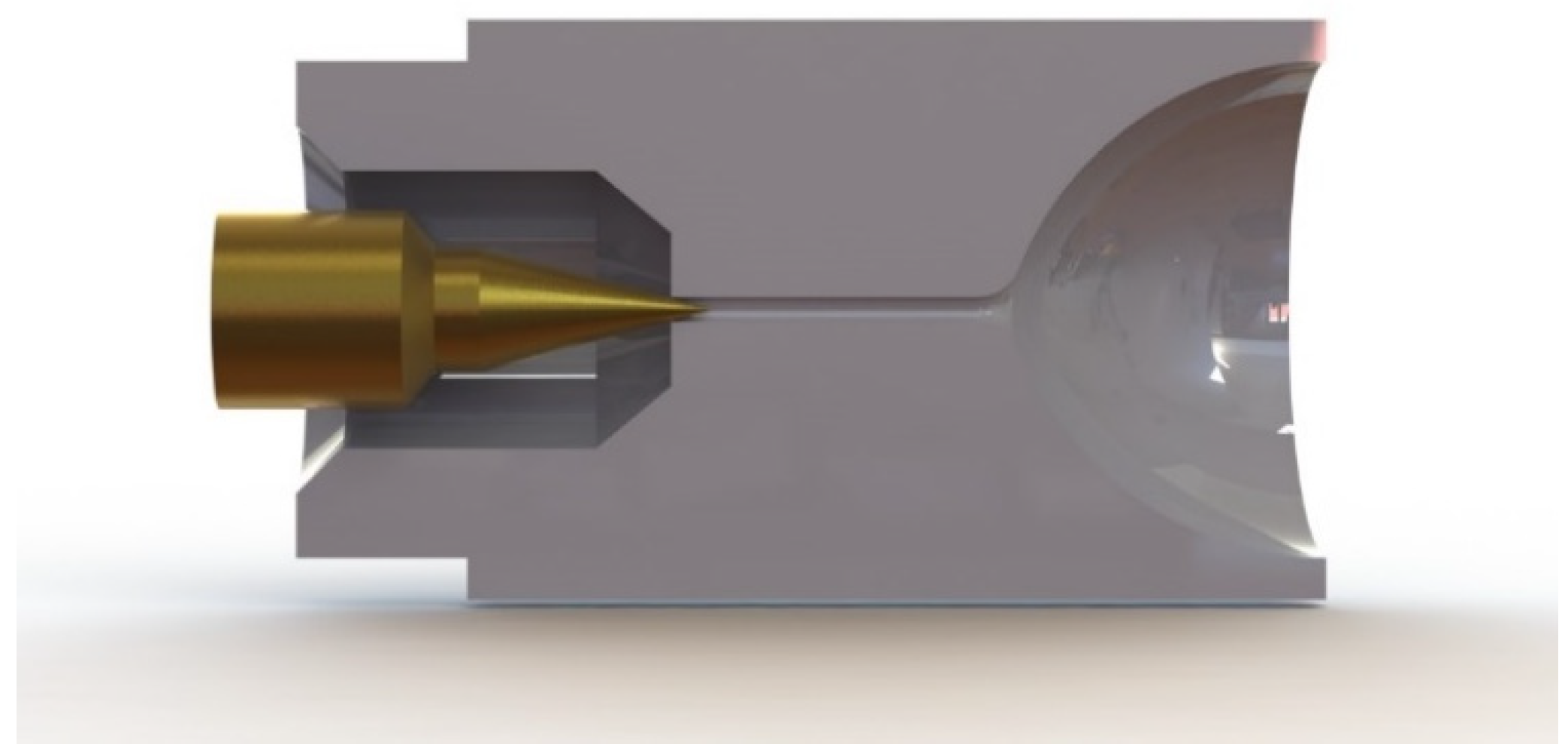



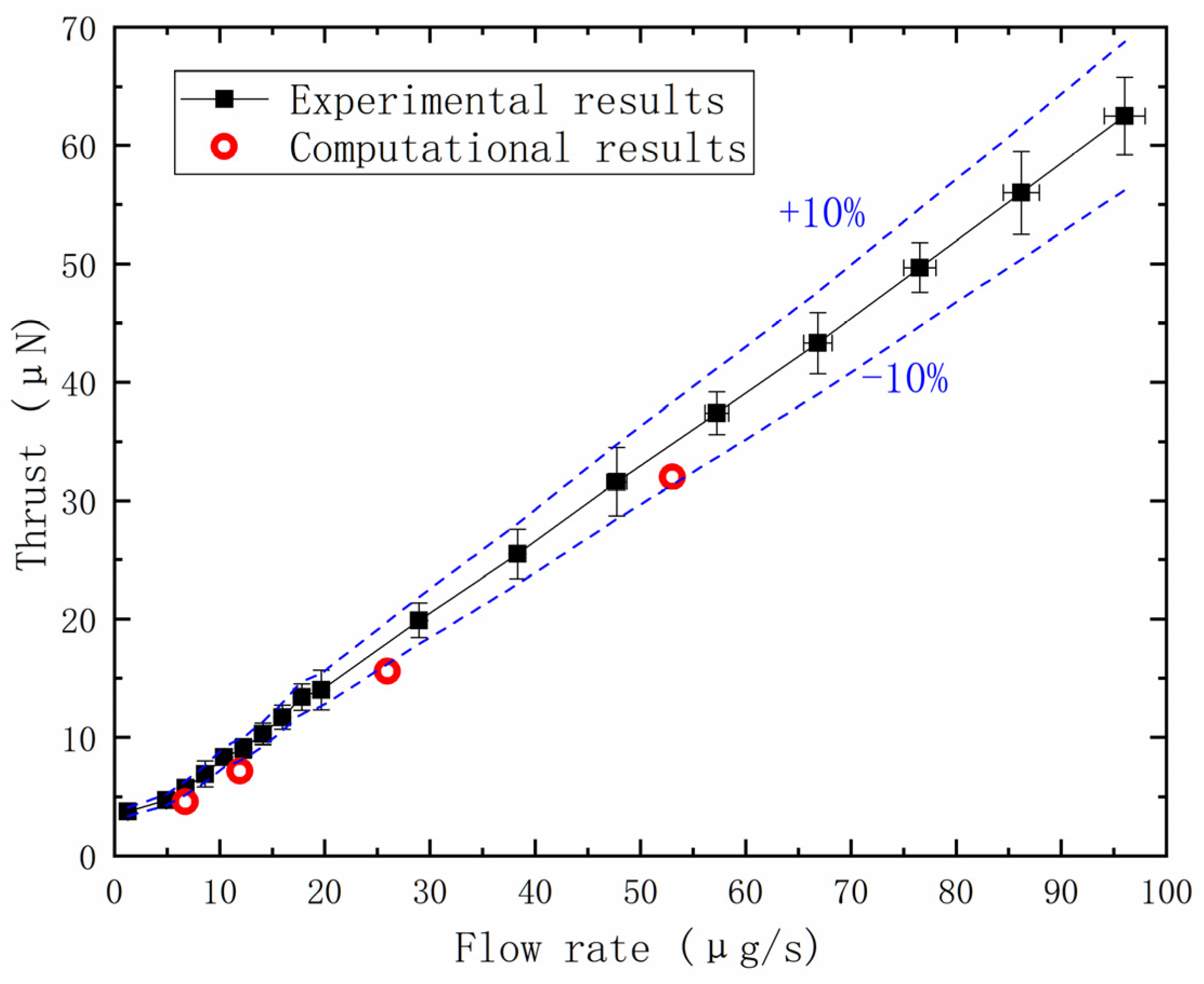
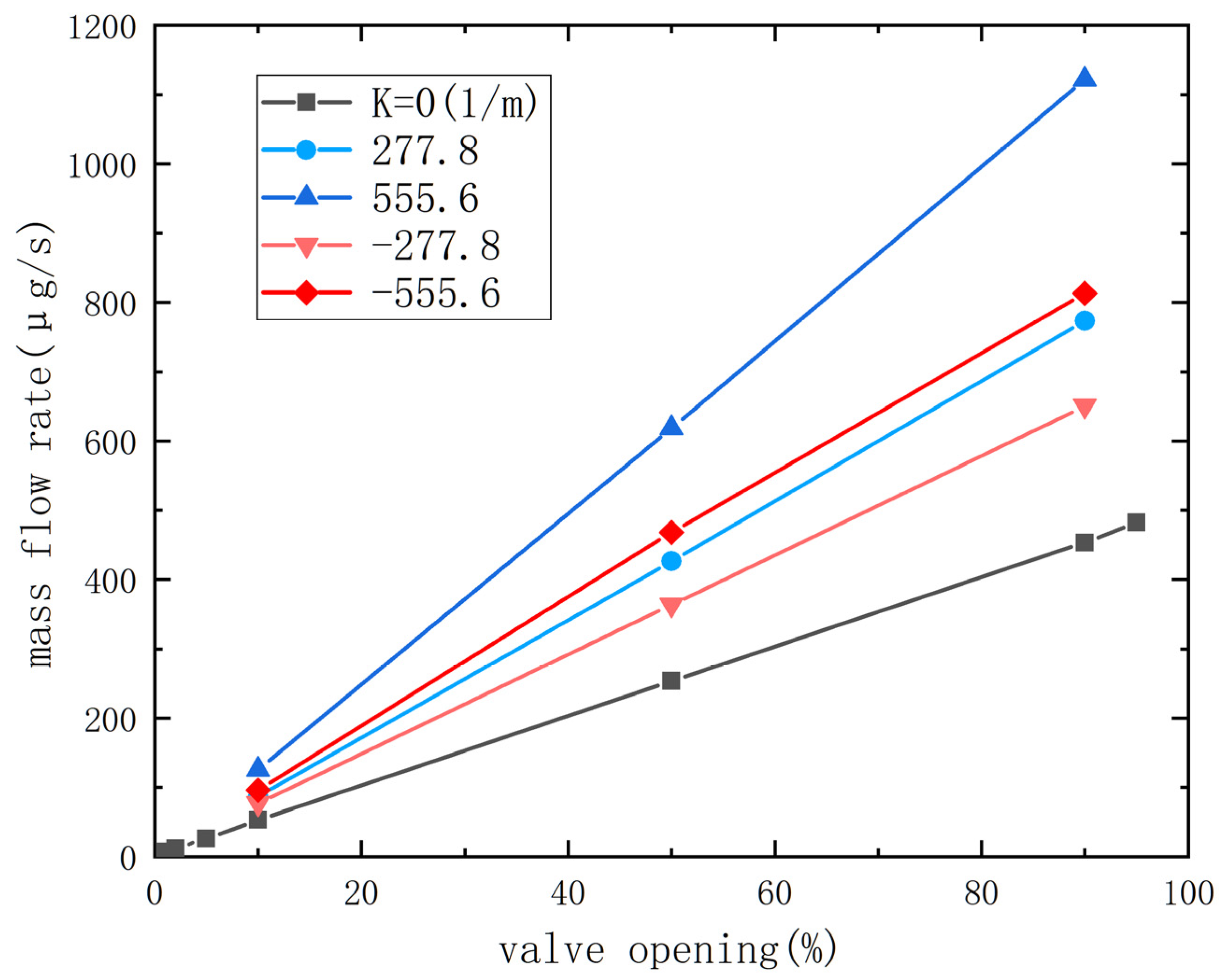
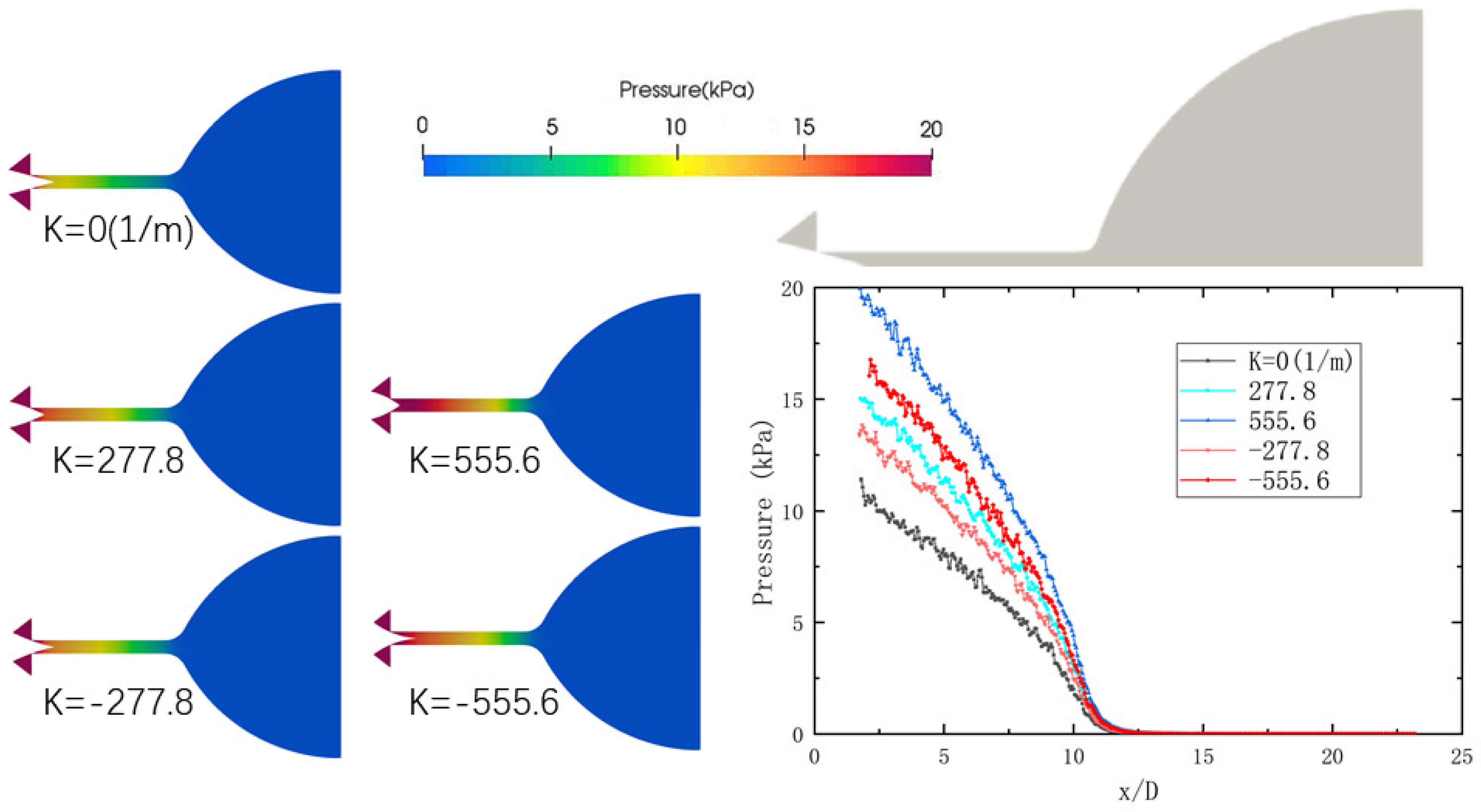
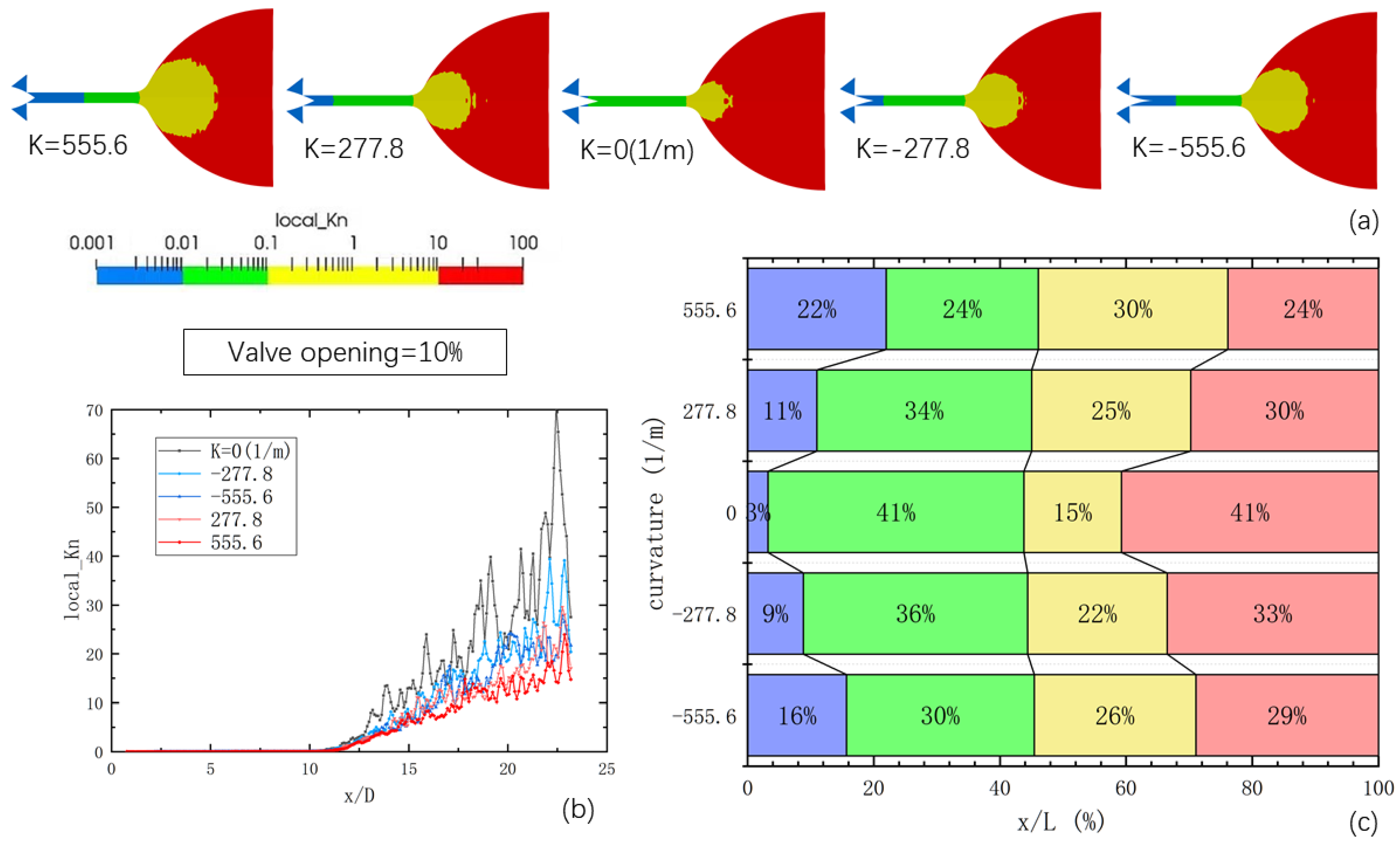
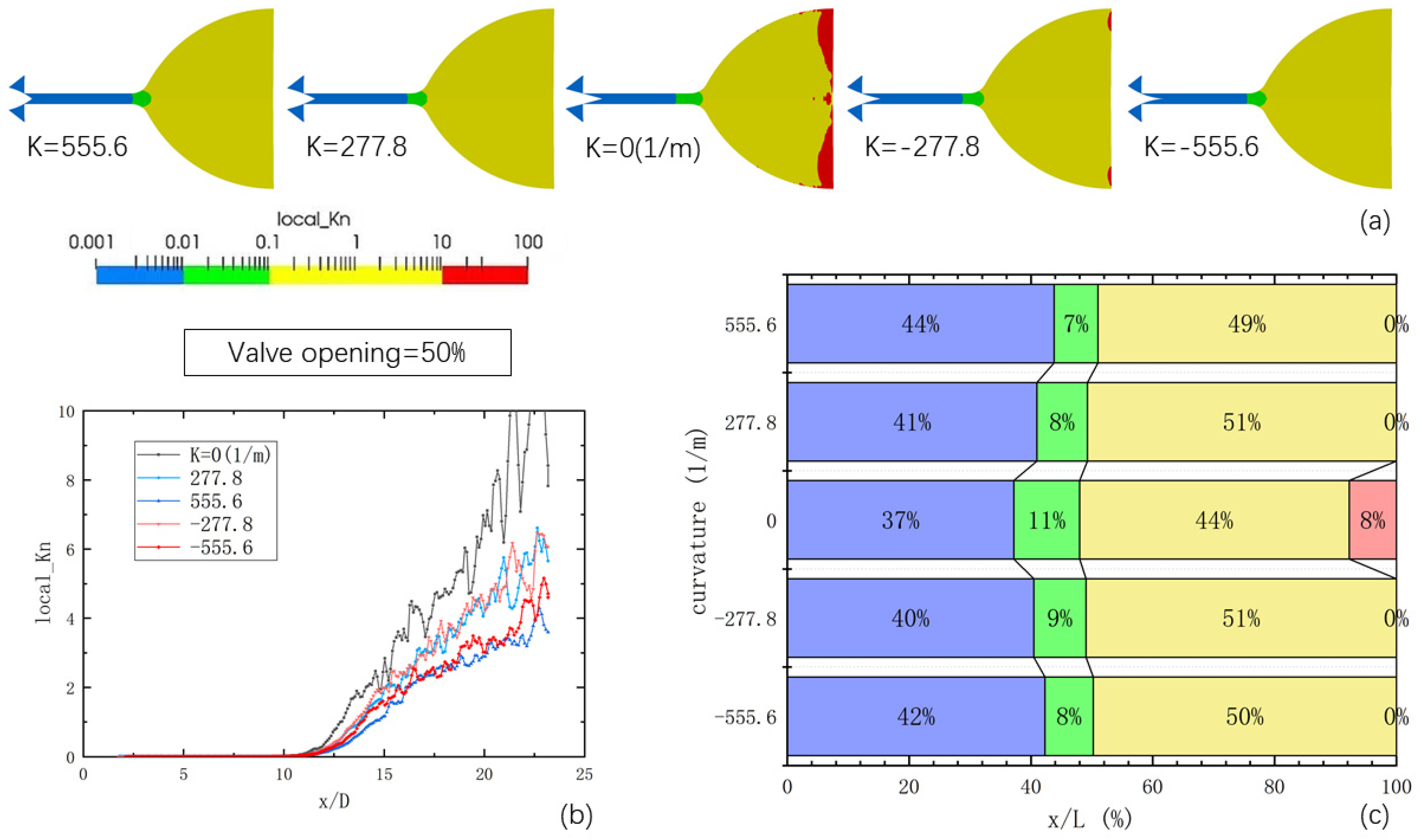



| Number of Axial Meshes | Number of Radial Meshes | Number of Circumferential Meshes | An Average Speed at the Exit (m/s) | Relative Error (%) (Grid7 as a Reference) | |
|---|---|---|---|---|---|
| Grid1 | 30, 40, 120, 60 | 20 | 4 | 413.7 | 7.63 |
| Grid2 | 30, 60, 140, 80 | 20 | 2 | 402.3 | 3.41 |
| Grid3 | 30, 60, 140, 80 | 40 | 2 | 392.2 | 1.79 |
| Grid4 | 30, 60, 140, 80 | 60 | 2 | 390.5 | 1.35 |
| Grid5 | 50, 80, 160, 100 | 40 | 2 | 390.1 | 1.25 |
| Grid6 | 70, 100, 180, 120 | 40 | 4 | 387.6 | 0.60 |
| Grid7 | 70, 120, 200, 150 | 40 | 4 | 385.3 | 0.00 |
| Valve Opening (%) | K = 277.8 (1/m) | K = 555.6 | K = −277.8 | K = −555.6 |
|---|---|---|---|---|
| 10 | 164.73% | 237.00% | 145.32% | 180.53% |
| 50 | 168.11% | 244.08% | 143.42% | 184.69% |
| 90 | 170.54% | 247.49% | 143.51% | 179.43% |
Disclaimer/Publisher’s Note: The statements, opinions and data contained in all publications are solely those of the individual author(s) and contributor(s) and not of MDPI and/or the editor(s). MDPI and/or the editor(s) disclaim responsibility for any injury to people or property resulting from any ideas, methods, instructions or products referred to in the content. |
© 2023 by the authors. Licensee MDPI, Basel, Switzerland. This article is an open access article distributed under the terms and conditions of the Creative Commons Attribution (CC BY) license (https://creativecommons.org/licenses/by/4.0/).
Share and Cite
Lu, S.; Liu, X.; Wang, X.; Zhang, S.; Yu, Y.; Li, Y. Direct Simulation Monte Carlo Simulation of the Effect of Needle Valve Structures on the Rarefied Flow of Cold Gas Thrusters. Micromachines 2023, 14, 1585. https://doi.org/10.3390/mi14081585
Lu S, Liu X, Wang X, Zhang S, Yu Y, Li Y. Direct Simulation Monte Carlo Simulation of the Effect of Needle Valve Structures on the Rarefied Flow of Cold Gas Thrusters. Micromachines. 2023; 14(8):1585. https://doi.org/10.3390/mi14081585
Chicago/Turabian StyleLu, Songcai, Xuhui Liu, Xudong Wang, Shurui Zhang, Yusong Yu, and Yong Li. 2023. "Direct Simulation Monte Carlo Simulation of the Effect of Needle Valve Structures on the Rarefied Flow of Cold Gas Thrusters" Micromachines 14, no. 8: 1585. https://doi.org/10.3390/mi14081585
APA StyleLu, S., Liu, X., Wang, X., Zhang, S., Yu, Y., & Li, Y. (2023). Direct Simulation Monte Carlo Simulation of the Effect of Needle Valve Structures on the Rarefied Flow of Cold Gas Thrusters. Micromachines, 14(8), 1585. https://doi.org/10.3390/mi14081585







